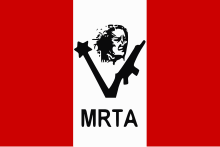Movimiento Revolucionario Túpac Amaru
The group Movimiento Revolucionario Túpac Amaru (short MRTA ), German Revolutionary Movement Tupac Amaru , was an underground movement in Peru that arose in 1984. The name goes back to the last Inca ruler Túpac Amaru , who was captured and executed by the Spaniards in 1572 as heir of the overthrown Inca kings.
Origin and development until the beginning of the 1990s
The MRTA emerged from the movement of the Revolutionary Left of Peru (MIR) and is mainly recruited from the indigenous population of Peru. Comparatively politically undogmatic, the MRTA fought primarily for the improvement of the miserable social situation of the indigenous rural population. The MRTA carried out acts of revenge against Asháninka in 1989 , accused of collaborating against MIR in the 1965 guerrilla war. This led to an uprising by the Asháninka, who subsequently occupied the city of Puerto Bermúdez in order to hand over MRTA members to the government. The MRTA also participated in forced recruitment among the indigenous population and in drug cultivation. In Europe, the MRTA enjoyed considerable sympathy among the left.
The Túpac Amarus expressly distanced themselves from the tightly organized Maoist Sendero Luminoso ( Shining Path ), which was led by Abimael Guzmán, who was arrested in 1992 . Remnants of the MRTA and the Sendero Luminoso are suspected in the Huallaga Valley.
The situation at that time is described in Death in the Andes by the Peruvian writer Mario Vargas Llosa , who was defeated by Alberto Fujimori of Japanese origin in the 1990 presidential election. Two years after his inauguration, Fujimori launched a coup against his own government with the help of the military . In September 1992, numerous leaders and members of the Shining Path and the MRTA were arrested in a large-scale operation - supported by the secret service and the military . After that, the activities of the two groups subsided. The Peruvian government under Fujimori finally disarmed a large number of the fighters through an offer of amnesty . By the end of 1994 6,400 rebels had given up their weapons.
Occupation of the Japanese embassy in 1996
The MRTA achieved worldwide attention again on December 17, 1996, when a heavily armed 14-man commando of the MRTA broke into the residence of the Japanese ambassador in the Peruvian capital Lima during a reception . Of the 800 hostages, more than 700 people, mostly women and children, were released on the same day. Among the German hostages were the permanent representative of the Ambassador of the Federal Republic, Jürgen Steinkrüger , and the development officer Hannspeter Nintzel. The hostage-takers demanded the release of all imprisoned Túpac Amaru members, in particular MRTA chief Victor Polay and his deputy Peter Cárdenas Schulte . During the months of occupation, the rebels repeatedly released individual hostages, with the mediation activities of the then Archbishop of Ayacucho , Luis Cipriani , a close confidante of Fujimori, playing an important role. On April 22, 1997, the army stormed the Japanese embassy and bloody ended the occupation. All 14 hostage-takers, including the then leader of the MRTA Néstor Cerpa Cartolini , two soldiers and a hostage who died of heart failure in the excitement and was not killed, were killed. The remaining 71 hostages were freed.
literature
- Michael Fobes Brown, Eduardo Fernández: War of Shadows. The Struggle for Utopia in the Peruvian Amazon. University of California Press, Berkeley et al. 1991, ISBN 0-520-07435-1 .
- Salomón Lerner Febres , Josef Sayer (Ed.): Against forgetting. Yuyanapaq. Report of the Truth and Reconciliation Commission in Peru. Matthias Grünewald Verlag, Ostfildern 2008, ISBN 978-3-7867-2720-0 .
- Charles F. Walker: The Tupac Amaru rebellion . Harvard University Press, Cambridge et al. 2014, ISBN 978-0-674-05825-5 .
Movies
- 1999: 127 days of fear of death (Lima: Breaking the Silence) , feature film, 90 minutes, among others. with Christopher Atkins (Cine Plus Home Entertainment GmbH)
- Alias Alejandro (Germany 2004, 93 min.). Documentary by DFFB student Alejandro Cárdenas (script and direction) about his approach to his father, the imprisoned MRTA comandante Peter Cárdenas Schulte (code name: Alejandro) (camera: Florian Schilling; editor: Cuini Amelio-Ortiz; music: Zort; production : sabotage films, Martin Cichy and Karsten Aurich, in co-production with ZDF / Das kleine Fernsehspiel and the German Film and TV Academy Berlin )
Web links
- Homepage of the MRTA (Spanish)
- Working Group on Research into the Causes of War (AKUF) on the MRTA ( Memento from June 10, 2007 in the Internet Archive )
- Embassy occupation 1996 from the perspective of the MRTA and its supporters (including the communiques of the MRTA) at nadir.org
- Final report of the Peruvian Comisión de la Verdad y Reconciliación (CVR) (the Peruvian Truth and Reconciliation Commission has published a balanced report on the Peruvian civil war; English, Spanish)
